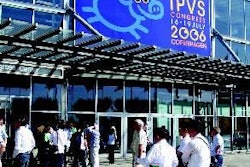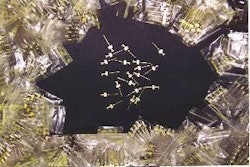
Over recent years we have become used to talking about PMWS (post-weaning multisystemic wasting syndrome) as the most obvious result of infection with the porcine circovirus called PCV2. Increasingly, however, it is being referred to by using the more general description of porcine circovirus disease, abbreviated to PCVD. With the adjustment in terminology there are also indications that the nature of the disease has changed, along with signs that it can genuinely be controlled by vaccination programmes.
In 2006 the story so far has been that of circovirus disease reportedly sweeping across Northern America. Although the pathogenic type 2 of the virus was first isolated there some years ago, until recently the effects of infection seemed to be more marked in other parts of the world when measured by the deaths of young pigs in affected herds. But it appears today that producers in North America are experiencing the same devastatingly high mortality rates (30-40%) in young growing pigs as were seen in Europe and Asia in the late 1990's.
Meanwhile the general situation in Europe has calmed somewhat. The acute effects of the disease have largely died down. The Europeans are now living with the chronic effects, in which mortality figures range between 0-10% depending on the success of disease control measures and the implementation of the management actions that have become known as the 'Madec 20 points'. These aim to reduce stress, limit pig-to-pig contact, improve hygiene and bring a reduction in the disease challenge on the most susceptible pigs.
It still remains to be documented in full, but there is no doubt among European producers and their veterinary advisers that the disease (or, more correctly, the resulting mortality) is now occurring later than when PMWS was first named. Then, the acute form was clearly a killer in the nursery/grower stage. Now, the chronic form of the disease attacks in the early finishing stages (see Figure 1).
There is still the disparity of sizes between affected and unaffected pigs (see photo). Producers in Europe speak of a '30kg syndrome' in which the pigs enter the finishing shed weighing 30 kilograms and come out the other end at 30kg, when all the others have grown to 100kg-plus. As they have discovered to their cost, this effect is as damaging as mortality on production efficiency.
The nature of the disease continues to be unravelled. While general agreement considers it to be associated' with porcine circovirus type 2 (PCV2), there are supporters of the idea that other factors are represented in the sequence of events leading to the expression of clinical signs. Almost anything and everything has been proposed as a candidate, from an unknown Factor X (possibly another virus still undetected) to PCV2 mutation, immunostimulation by vaccines, immunosupression by other viruses (PRRS and PPV), bacterial infections, genetics, feeding and mycotoxins,
The disease has spread like an infectious agent, across countries and now even across continents. Pig movement and contact, transfer of semen and proximity to infected premises all seem to play a major role in its transmission. The acute form (high mortality) followed by a build-up in the herd immunity and the subsequent chronic form (lower grumbling mortality) all suggest that it is caused by an infectious agent.
Examination of affected pigs at post mortem has the typical finding that the lymphoid cells in the lymph nodes appear to have been invaded and destroyed by macrophages (the body's immune cells that eat up foreign proteins and even bacteria) which are usually full of ingested PCV2. The lymph-node cells produce the pig's immune response to an infection. This involves both antibody production and the stimulation of the cell-mediated response, in which cells and not antibodies help to overcome the infection. However, it is still not clear whether the PCV2 infection alone is responsible for causing the initial damage to the lymphoid cells and this then attracts the macrophages to destroy the animal's own immune system. Further work needs to be done on describing the mechanisms involved.
We have waited a long time for a vaccine to be produced. The key question has to be: a vaccine against what, if there are a number of other viruses and factors potentially involved? At last, though, a PCV2 vaccine for use in sows has been devised and has been provisionally licensed in Canada. It has also been made available in France and Germany under a provisional licensing system.
Its results have shown that there can be improvements in growth rate and reductions in mortality by stimulating the sow's immunity and passing higher levels of maternal antibody to the piglet. In the case of naïve herds located in primary breakdown/high-risk areas such as Canada, this vaccine could potentially reduce the acute effects (high mortality) of the disease. However, recent work by McKeown and others researchers from Blacksburg, Virginia, and Ames, Iowa, in the USA has demonstrated that although the presence of high levels of maternally derived antibodies prevents the onset of viraemia (PCV2 circulating in the blood), no similar prevention occurs at low levels nor when levels fall after several weeks.
This American research tends to support the observations regarding acute and chronic forms of the disease. The acute form strikes when there are no (or few) antibodies to do battle in the face of a primary breakdown from virus challenge. The chronic form sees disease expressed later, in piglets that had been protected initially by maternal antibodies until the protection subsided and a challenge occurred.
Further, recent developments with new PCV2 vaccines given to young growing pigs have shown outstanding results in field trials. Vaccination offered protection throughout the growing and finishing period and reduced mortality to almost pre-PMWS times. This is highly significant in 3 ways. Firstly, it demonstrates the efficacy of the PCV2 vaccine. Secondly, it confirms that the disease expression is primarily a result of PCV2 infection. Thirdly, it shows that immunostimulation in young pigs in other words, piglet vaccination is not important if the primary virus (PCV2) is controlled.


















